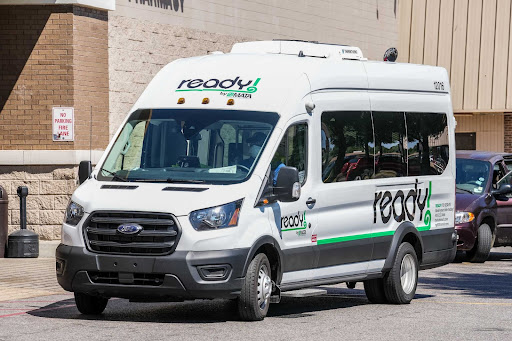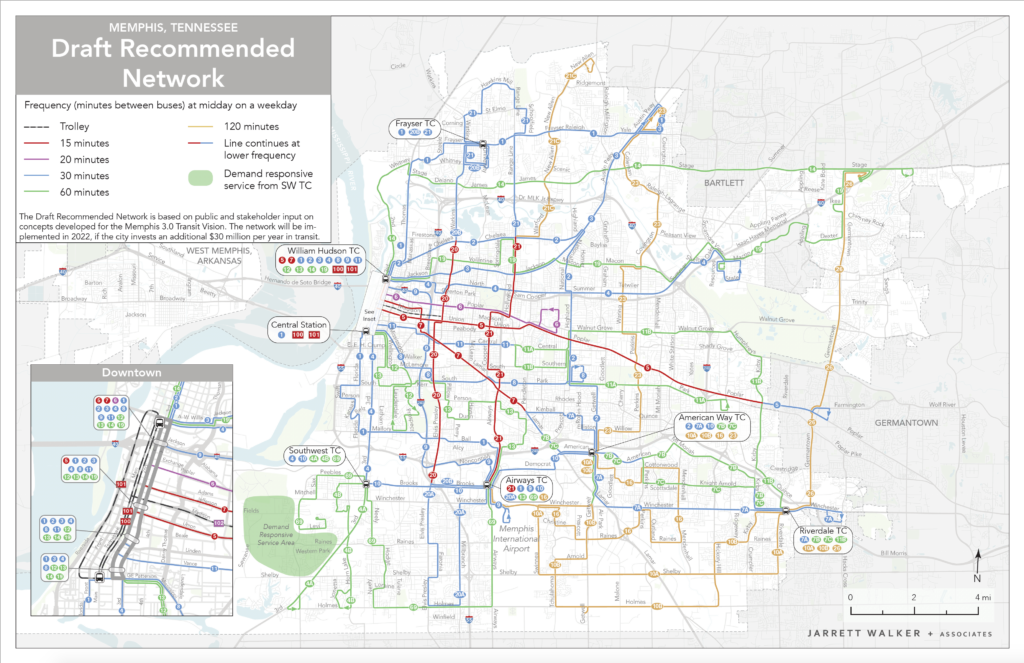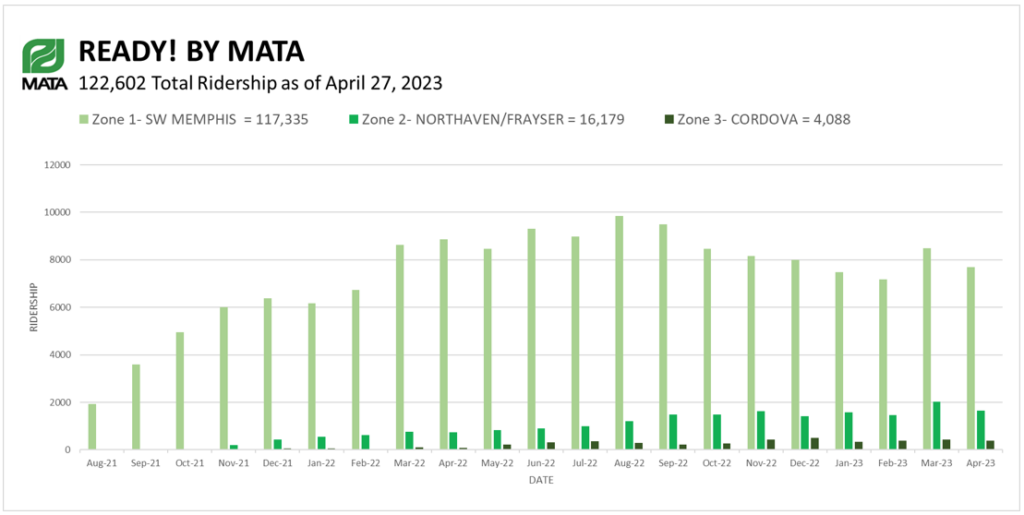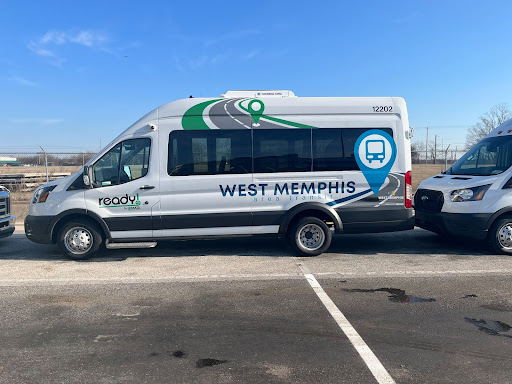Ready, Set, Go!: Using Microtransit to Overcome Transportation Barriers with MATA Ready!, Memphis, TN
20 minutes Author: Shared-Use Mobility Center Date Launched/Enacted: May 1, 2023 Date Published: May 1, 2023

Brief Summary
- In 2018, the Memphis Area Transit Authority (MATA) began developing an on-demand microtransit project to address transportation access challenges in areas of the city with unreliable fixed-route service.
- Through the Memphis Transit Vision, an initiative to redesign the city’s transit network through community engagement, MATA identified an area in the southwest of the city that could benefit from a new microtransit service.
- MATA built off of work done through the Shared-Use Mobility Center’s MOD On-Ramp Program to develop Ready!, an on-demand, curb-to-curb microtransit pilot. With support from a Federal Transit Administration (FTA) Integrated Mobility Innovation (IMI) grant, Ready! launched its service in southwest Memphis in 2021, later expanding to three zones throughout the city.
- MATA launched Ready! as a free to ride pilot service supported by the IMI grant. MATA is working to develop an integrated payment system for its whole system and will introduce fares to the service when this process is complete.
- The IMI grant implementation period ended in March 2023. MATA will continue to operate Ready! funded through the City of Memphis and the Congestion Mitigation and Air Quality program. MATA further intends to expand Ready! into new zones, including one in West Memphis, AR.

This pilot project is part of the Mobility Innovation Collaborative (MIC) program. The MIC program provides a comprehensive suite of technical assistance resources, promotes knowledge sharing activities, and captures stories and lessons learned from nearly 50 innovative mobility projects across the United States.
Video interview with John Lancaster, Chief Development Officer at the Memphis Area Transit Authority.
Credit: Shared-Use Mobility Center (SUMC)
Introduction
Even in large urban areas with fixed-route bus networks, there are communities which lack sufficient access to public transit. These communities may have low density land uses or have street design features that make it difficult to run bus service and access bus stops, like incomplete sidewalks, insufficient street lighting, or barriers to circumnavigate like train tracks crossings. Challenges like these can affect fixed-route service’s reliability and make it inconvenient for riders. On-demand microtransit can improve accessibility to transit service in neighborhoods presenting these challenges, providing a level of flexibility and convenience to residents that fixed-route buses often can not.
The Memphis Area Transit Authority (MATA), serving Memphis, Tennessee, identified neighborhoods in the city with low bus ridership, challenging conditions to run fixed route service due to various barriers, and with communities relying on public transit, to pilot microtransit as an alternative mode to provide transit service. After a thorough research and development process, MATA launched Ready!, a technology-enabled, zoned, on-demand microtransit service, using funding from a Federal Transit Administration (FTA) Integrated Mobility Innovation (IMI) grant.
History of the Program
MATA began the development of its Ready! project in 2018 supported by the Shared-Use Mobility Center (SUMC)’s Mobility on Demand (MOD) On-Ramp Program. The MOD On-Ramp Program was a comprehensive initiative supported by the FTA which helped transit agencies develop business plans, create project strategies, and provide pre-implementation support for promising MOD projects. MATA was one of the six agencies selected for the program, and sought to develop an on-demand service to act as a first and last mile solution in parts of MATA’s service area that were low-density and had poor fixed-route transit service.
MATA’s On-Ramp project built off of work done through the Memphis 3.0 Comprehensive Plan, a planning process led by the City of Memphis. As part of that comprehensive plan, the City of Memphis and Innovate Memphis, in partnership with MATA and the Memphis Urban Area Metropolitan Planning Organization (MPO), led the development of the Memphis Transit Vision to redesign the city’s transit network through community engagement to improve transit access. Through this process, Memphis identified an area in the southwest of the city as challenging to continue servicing with fixed-route buses and as a suitable location for a MOD pilot project. The service area comprises Memphis’ low density Boxtown and Westwood neighborhoods, which are predominantly minority and low income communities. While MATA previously served these communities through the Route 38 bus, this route ran with low frequency and encountered many barriers along its route (for example, the route crossed freight rail lines and navigated through disconnected streets), which resulted in underperforming service and overall low ridership.

Draft of the recommended bus system network of Memphis developed through Transit Vision. Credit: Transit Vision
MATA’s initial goal was to develop a plan to create a microtransit service in this area to supplement fixed-route service, provide first and last mile connections, and improve mobility access. Through the MOD On-Ramp program, MATA extended this service area into parts of the Whitehaven neighborhood, east of the previously identified target zone, to encompass more commercial, healthcare, and social service destinations. Through this process, Ready! moved past being only a first and last mile solution to also being an option that could connect riders directly with key destinations within its larger service area. Following the MOD On-Ramp Program, MATA applied for funding through the FTA’s IMI grant program, and was awarded $394,000 to implement the Ready! project. Ready! officially launched in July 2021, in the newly expanded service area.
Given Ready!’s success serving southwest Memphis, in November 2021, MATA added two additional service zones to Ready!. The second zone covers the Frayser neighborhood and Northaven, an unincorporated community Northwest of the city; and the third zone covers Cordova, an unincorporated community east of Memphis. These communities had similar characteristics and challenges to the original zone: largely minority and low-income communities, low density, and insufficient fixed-route transit service. With the experience of operating Ready! in southwest Memphis already, MATA was able to replicate the service and bring on-demand microtransit to the new zones quickly and easily. However, the ability to replicate the service in different areas of the city with similar characteristics have not automatically produced the same outcomes in terms of ridership and usage.
Program Operations
MATA uses Ford transit vans for Ready!, which transitioned from the MATAPlus paratransit service. Each van is wheelchair accessible, and can carry up to 8 passengers. Ready! is a curb-to-curb service, accessible through the Go901 mobile app, website, or MATA’s call center.
Ready! operators are already employed by MATA, and also drive for the MATAPlus paratransit service. Thus, they were already familiar with MATA’s operating procedures and safety protocols, and trained to address the needs of elderly and disabled passengers when they came onto the project. MATA drivers are unionized, with the union separating drivers based on type of service. While it is possible for paratransit and microtransit drivers to easily switch between those modes, union contract rules currently prohibit drivers of other modes to drive microtransit. Thus, a MATA fixed-route or trolley driver cannot drive for microtransit. In light of a driver shortage, these rules have occasionally posed challenges to fully staffing the microtransit pilot, but MATA leadership and union leadership collaborate regularly and are working on finding solutions to allow for more flexibility in driver allocation.
During the first year of Ready!’s rollout, MATA made the service zero fare. MATA plans to implement a new fare system, which includes mobile payments, smart cards, and new ticket vending machines, but is facing delays, in part due to the COVID-19 pandemic. When the fare system is operational, MATA will introduce fares for Ready!, which will have the same cost as MATA’s fixed-rate fare of $2 per ride.
MATA works with TransLoc as a technology partner for Ready!. TransLoc’s technology lets riders use the Go901 mobile app to book rides, allows for real-time communication with riders through text messages to convey trip information, and provides dynamic dispatching and routing to send vehicles in the most efficient manner using real-time demand information. Other partners for the Ready! project include the University of Memphis and Innovate Memphis.
Program Goals
MATA’s initial goal with the Ready! project was to create better connections for the communities within the service areas. Many of the targeted neighborhoods have significant barriers to fixed-route public transit access, including stretches with no sidewalks, insufficient street lights, and overall low density. MATA learned throughout the development process that, because of these issues, concerns about safety and security walking long distances to bus stops were prevalent in the neighborhood. On-demand microtransit was a strategy to mitigate these safety concerns by offering a curb-to-curb public transportation option.
Additionally, MATA hoped that replacing the fixed-route buses would increase accessibility to jobs, education, healthcare, and other social services. In particular, MATA identified a need for transportation to local charter schools that Ready! could help fill.
MATA closely monitors Ready! ridership as a key performance metric, and has seen it rapidly grow since the service launched. As ridership for all MATA modes slowly increases as it returns to pre-pandemic levels, ridership for Ready! in particular has increased dramatically, surpassing expectations. In its first month of operation, August 2021, Ready! provided just under 2,000 rides. One year later, that number grew to nearly 10,000 rides in the month of August 2022. As of April, 2023, Ready! provides 600-700 rides per day, with over 122,000 total rides since it launched. While MATA is managing the increased demand, the agency anticipates that demand will plateau if high ridership eventually leads to longer wait times.

Graph of monthly Ready! ridership as of April 27, 2023. Credit: MATA
Community Outreach
Transitioning from fixed-route service to on-demand microtransit brought various community concerns, and MATA has held outreach programs since early in Ready!’s development. The planning phase involved a series of meetings and outreach events with existing MATA riders, community stakeholders, and residents to educate them on the differences between service modes, and prepare them for the upcoming transition. Based on input from these events, MATA adjusted Ready!’s service area prior to launching the service to include more destinations and points of interest that community members requested. In this way, MATA worked with the southwest Memphis community to design Ready! so that it could best serve the needs of the community.
In addition to pre-planning outreach, MATA has ongoing outreach efforts through social media to promote and educate about Ready!. MATA also has a partnership with the Memphis Grizzlies, and promotes MATA’s services, including Ready!, at basketball games. MATA also uses this forum as another way to recruit new operators and employees.
In May, 2022, once Ready! was well-established in the community, MATA decided to capture one regular Ready! rider’s story through a video interview, to showcase the positive impact the service has made on her life. As a marketing effort, this initiative allowed MATA to promote Ready! through the eyes of someone in the community to others who may not have heard of it, and it further became a way for MATA to continue engaging with Ready! users.
Challenges and Lessons Learned
Developing Ready! was a long process; MATA began work identifying the service areas, planning, and gathering input from the community years before the service launched. The focus on carefully building out long-term plans was integral to making Ready! viable and sustainable. For MATA, it was imperative to have thorough plans and include input from the communities that the new services will affect. Every community is unique, and plans must reflect those unique needs.
MATA’s most significant challenges with Ready! have been around the implementation of the fare system. The process of creating a fare system and integrating it with various mobile app technologies involves working closely with MATA’s technology partners. Due to issues spurred by the COVID-19 pandemic and rapid changes happening within the tech industry, some of these partners have experienced company reorganizations, high staff turnover, or changes in ownership, all of which impact this project’s development. At times, MATA has had to change providers altogether to meet the project’s technology needs.
Another significant challenge with the Ready! project has been staffing for the new service. Like many other agencies across the country, MATA is facing operator shortages, due in part to the COVID-19 pandemic. MATA has so far been able to meet demand for the service, partially because operators do not need commercial drivers’ licenses to drive Ready! vehicles, which widens the pool of available operators. However, some of Ready!’s expansion efforts have been hindered because of staffing shortages, even if all other aspects of the service are ready to launch. In particular, MATA is prepared to bring Ready! to West Memphis, Arkansas, and has vehicles procured, wrapped, and ready to deploy, but has put the launch on hold because the agency does not have operators available to drive them. MATA is undertaking extensive recruiting efforts, including offering signing bonuses, enacting a digital recruiting campaign, and leveraging the partnership with the Memphis Grizzlies to advertise positions at games.
Future Plans
The implementation period of the IMI grant ended in late March 2023, and MATA’s focus is now on improving and expanding the service. Ready! will continue to be funded with operating funds from the City of Memphis general budget, which City Council approves on a yearly basis, and with capital funding through the Congestion Mitigation and Air Quality (CMAQ) program, administered on a discretionary basis through the Tennessee Department of Transportation.
MATA has been working with the Memphis Urban Area Metropolitan Planning Organization to study other potential zones around the metropolitan area that could be good fits for future Ready! expansion efforts, and is finalizing plans for one of these expansion areas in West Memphis, Arkansas, a suburb of Memphis directly across the Mississippi River. MATA had previously served West Memphis with fixed route service, but that ended in 2020 due to funding challenges. Through a partnership with the City of West Memphis, MATA plans to introduce five co-branded wheelchair accessible vehicles to the city with a target launch date of July 2023, using funds from West Memphis to cover operational costs.

A West Memphis Ready! Van. Credit: MATA
Ready! is currently zero fare, however MATA is actively working on developing a full fare system, with mobile app integration. Once this system is implemented and operational, Ready! will cost $2 per ride, the same cost as MATA fixed-route services. The new fare policy will aim to make it easier for riders to use Ready! as connection to fixed-route transit, simplify trip planning and payment, and facilitate more seamless travel throughout the city. As Ready! is facing increasing demand and longer wait times, full implementation of the fare system will also likely help MATA balance the supply and demand and ultimately improve Ready! service.
While Ready! replaced some fixed-route buses, some of the service zones still have bus routes operating concurrently with Ready!. In addition to monitoring microtransit ridership, MATA is also collecting data on bus ridership in Ready! zones to better understand how microtransit facilitates fixed-route connectivity. In Fall 2023, MATA will work with the Memphis Urban Area Metropolitan Planning Organization and Nelson Nygaard to administer a survey and perform an analysis on travel demand for Ready!. Through this effort, MATA hopes to better identify travel patterns, learn to what extent Ready! may be cannibalizing fixed-route service, and find ways to improve Ready! overall.
Conclusion
MATA Ready! emerged as an innovative solution to make public transit more accessible to areas of the city with large transportation barriers. Not only does Ready! serve as a first and last mile connector, improving access to other MATA services and community destinations that would have been difficult to get to otherwise, but Ready!’s curb-to-curb service model improves safety, security, and comfort for community members who previously had to traverse patchy sidewalks and unlit streets to get to bus stops.
MATA identified where microtransit could be most effectively implemented through a long and careful planning process, and continues to refine and expand Ready! service. Ready! exemplifies how an agency can use microtransit to fill in gaps in its transportation network and make communities more connected.
Key Considerations for Implementing a Microtransit Service
- How is your current transportation system meeting or not meeting the needs of your community? What needs can an on-demand microtransit service address that your existing services do not?
- What other mobility services exist in your area? How do you plan to connect, coordinate, or integrate this service with others? Will the planned microtransit service replace existing transportation services or supplement them?
- Who are your target users?
- What criteria define your service area? Will you operate in specific zones, or bring the service to the entire community?
- What are the technology needs of your agency in implementing on-demand transportation? What might you need from a technology partner?
- What staffing needs do you anticipate? Do you need to hire new staff to support the new service? How do you plan to hire and retain operators?
- Are you able to support your program with your agency’s existing vehicles? If not, how do you plan to supplement them? Can you contract with an outside provider to help with your service?
- What performance metrics do you intend to collect? How do you plan to analyze and report that data?
- Are you planning on expanding the service in the future? If so, how will you ensure that it will be scalable?
SUMC and MATA acknowledge key people and partners involved in Ready!’s development process:
- Gary Rosenfeld, Chief Executive Officer, MATA
- Tiena Gwin, Project Manager, MATA
- Scott Fox, Former Service Planner, Bus Stop and GIS Manager, MATA
- Scarlet Ponder, Former Transit Planner, MATA
- Suzanne Carlson, Former Transportation and Mobility Project Manager, Innovate Memphis
- Courtney McNeal, City Innovation Director, Innovate Memphis
- The University of Memphis